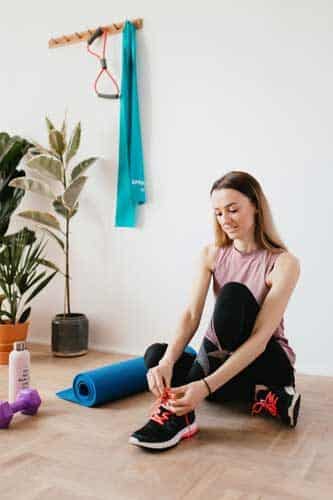After months of gym closures and restrictions around the country, chances are you’re already acclimated to working out at home or considering it. While many of us do not have perfect gym environments in our homes, fortunately, with a few simple tricks and awesome arms workout equipment, we can make home workouts more enjoyable and effective.
Create a Fitness Space
Allocating a portion of a room as your training space is an excellent approach to ensure that you benefit from home workouts. To begin, you’ll have everything you need in one location, which means you’ll spend less time looking for fitness equipment and more time exercising.
This room should only be used for hard work or exercise. This will be your exercise place where you can frequently go with few interruptions and where family members know to leave you alone.
This can help you mentally prepare for your workout. Experts advise that the best course of action is to make your environment useful and convenient, if you feel cramped or it’s inconvenient to bring equipment out or rearrange furniture, you’re less likely to perform any exercise [1].
You don’t have to go overboard; In the corner of your bedroom, simply place a yoga mat or lovely towel, along with some resistance bands or weights.

Try Music
Whether you’re riding your favorite Peloton bike or performing an at-home strength training session, listening to upbeat music can make all the difference. Music can quickly transform an uninterested mood into a workout-crushing mood.
Even studies have reported that people who try music along with exercise perform better and are more likely to engage in physical activity [2].
When you hear a song that makes you bop your head, it motivates you to do more rep. Additionally, it diverts your attention away from the muscle burn. Therefore, the next time you try to abandon your sweat session, try turning on one of the numerous workout tracks available on an app like Spotify and see how it affects your mood.

Adjust Your Timing
When pursuing physical exercise goals, finding a constant “when” might help you stay on track. This will seem different for each individual: You might set a specific time each day to exercise, or you can simply try to do some aerobic exercise in the afternoon before dinner.
Whatever your preferred method of exercise is, set a schedule and you’ll be less likely to skip a workout—and more likely to look forward to it as a means to recharge and reset during hectic times [3].
Think about your entire schedule while developing a home workout routine that feels manageable on a regular basis. Morning workouts may not be feasible for you if you are required to be on a work Zoom call at 8:00 a.m. each weekday or you have a job in the morning.
Rather than that, you could set aside 30 minutes in the middle of the day to get moving; then get a quick lunch before returning to work. Are you a night owl? Perhaps set an alarm at 7:00 p.m. to disconnect from work or chores and find an Obé Fitness program to do in your living room. It’s all about figuring out which system works best for you.

Move-In A Manner That Is Comfortable for You
If you find yourself dragging through the same exercises every day or are intimidated by the thought of hour-long sessions, keep in mind that the best type of activity is one you enjoy, as this is the type of activity you are more likely to engage in constantly.
Are you in need of some inspiration? Fraticelli introduces this training concept that combines efficiency and variety. His preferred circuit consists of 20 squats in one minute, followed by 15 lunges the next minute, 15 pushups the third minute, and 15 sit-ups in the fourth minute.
You can repeat this sequence 4 or 5 times for a total of 20 minutes of high-intensity exercise. Movement can be brief and succinct—yet highly impactful.
Studies have shown that High-intensity training has been linked to giving different advantages, including stress reduction and enhanced heart health [4]. If you’re trying to lose weight, this type of movement may also provide faster results.
Once you’re aware of this, you may find yourself sneaking into action throughout the day—in your car, during video calls at work, or even while brushing your teeth.

Choose Workout Clothing That You Adore
While you may not be interacting with other gym-goers or sweating alongside your workout partner, wearing clothes that you enjoy can help fuel your activity. Do what makes you feel good! Every little bit of motivation helps.
By “workout clothes,” does not mean that you have to wear fancy, expensive workout clothes. If your old sports shirt makes you high, and unstoppable, you can wear it and might comfortably move in it. It can even be as simple as a pair of socks that make you smile every time you look down!
Or you can prepare yourself as though you’re going to the gym. When you’re dressed in sports clothing, you’ll feel more motivated to exercise. If your closet feels out of reach, stock up on training gear in a nearby washroom. In this way, you can easily choose workout clothes or daily clothes.
Additionally, you may find it beneficial to put on your running shoes 15 minutes prior to your workout. While wearing your shoes, do some dishes or pick up some toys. It’s an excellent approach to warm up and gain some extra energy prior to starting your workout.
Warm-up is essential before starting any workout because it prepares you for strenuous activity. You can try some easy stretches before starting your workout routine.

Conclusion
Home workouts are best for both physical and mental health. It’s ok if you can’t go to the gym, you can do the essential exercises at home. For this purpose, you have to commit to the schedule and trust the process, and you will be on your way to living a happy, healthy life.
If you have liked reading the article, please tell us in the comment section and share the article.
References
1. Reed JA, Phillips DAJJoACH. Relationships between physical activity and the proximity of exercise facilities and home exercise equipment used by undergraduate university students. 2005;53(6):285-90.
2. Hallett R, Lamont AJQRiS, Exercise, Health. How do gym members engage with music during exercise? 2015;7(3):411-27.
3. Kendzierski DJJoASP. Decision Making Versus Decision Implementation: An Action Control Approach to Exercise Adoption and Adherence 1. 1990;20(1):27-45.
4. Shiraev T, Barclay GJAfp. Evidence-based exercise: Clinical benefits of high-intensity interval training. 2012;41(12):960-2.










